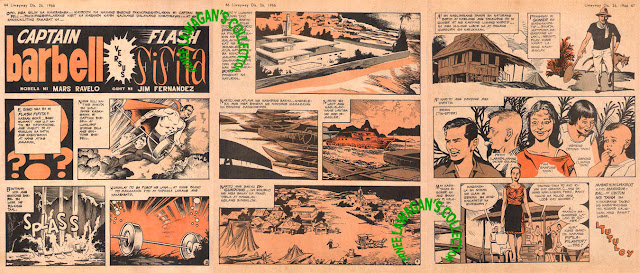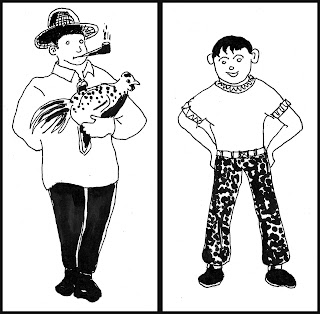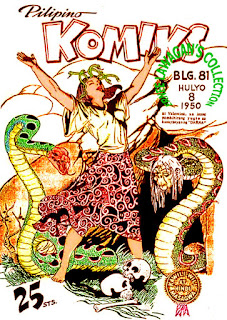One who is not familiar with Mars Ravelo’s Captain Barbell character would quip that it’s ridiculous. Some would even say that the character is laughable. How in the world would anyone think of creating a superhero whose power is dependent on a barbell? But there is a story behind it.
It all started with another immortal character created by Ravelo – Darna. Many writers today believed that Darna is a copycat of Wonder Woman. This is actually a case of “racist” misinformation. Ravelo’s concept of Suprema/Varga (Darna’s predecessor characters), which he called “Kamanghamanghang dilag” (Wonderwoman) predates that of Wonder Woman.
In 1939, after seeing Superman in the first few issues of the Action Comics and newspaper comic strips, he created Varga as the female counterpart of Superman, which initially he called Suprema. The name Suprema is the female equivalent of Supremo (Tagalog for "highest rank leader), which is also the nom de guerre of Andres Bonifacio. He later changed his mind because the name might create controversy since he hailed from Cavite, the home province of Emilio Aguinaldo. He started telling his story and showing his creation, clad in more or less a Philippine flag-like costume, to his American friends as the Philippines’ answer to Superman. He believed in the concept that the U.S. is male and the Philippines is female. Unfortunately, several publishers including Liwayway turned him down saying that “a female superhero won’t sell.” So he archived it until after World War II when it was first published it Bulaklak (Hiyas ng Tahanan) Vol. 4 No. 17 on July 23, 1947. He was, however, disappointed when Wonder Woman came out in All Star Comics #8 in December 1941. Ravelo sincerely believed that Charles Moulton, the creator of Wonder Woman, was here in the Philippines sometime in 1939-1940, and was allegedly one among those who heard his story of Suprema/Varga (During his early twenties, Ravelo was quite vocal in storytelling about his komiks ideas). He sincerely believed that some of the concepts of Varga, his “Wonderwoman from the Planet Marte” was bootlegged.
 |
|
Captain Barbell
(Pinoy Komiks #8, August 29,
1963)
Notice how Jim
Fernandez illustrated Tenteng, Captain Barbell’s alter-ego. Does he not look like Dolphy? |
Ravelo vent out a sort of retaliation on the Captain Marvel character, which like Superman he also likes very much. This time, he admitted doing the spoofing himself, and out came Captain Barbell. He tailor-made the character Tenteng (Captain Barbell’s alter-ego), to Dolphy, who was then a comical skinny actor, as a pun or insult, as opposed to the matinee-idol type Billy Batson (Captain Marvel’s alter-ego). He specifically told illustrator Jim Fernandez about that, and you can see the obvious similarity between Dolphy and Tenteng in Fernandez’ drawings (“Captain Barbell,” Pinoy Komiks, 1963). He even intended the character to have a funny transformation, that Captain Barbell would turn into a skinny bungling superhero (Ravelo, however, later changed that story, which became “Captain Barbell vs. Flash Fifita”). (Un)Fortunately, Captain Barbell became a great hit and Dolphy made his character Tenteng quite a sensation. So, Ravelo changed his mind and continued the legacy of Captain Barbell.
In the original Captain Barbell komiks series (May 23, 1963 – June 18, 1964), and in the first movie, Tenteng was a laughable skinny young man very much maltreated by his four step-brothers, Bruno, Badong, Baldo and Banong. When I asked Uncle Mars what was Tenteng’s full name, he revealed that it was originally Penitente Mumolingot, and smirkingly hasten to add “huwag mo ng itanong” (don’t bother to ask). When I asked Tita Lucy (Ravelo’s wife) years later, she didn’t know about the “Mumolingot” surname but told me that Tenteng was actually taken from the name of a tall lanky boy who bullied Ravelo as a kid.
In the original Captain Barbell komiks series (May 23, 1963 – June 18, 1964), and in the first movie, Tenteng was a laughable skinny young man very much maltreated by his four step-brothers, Bruno, Badong, Baldo and Banong. When I asked Uncle Mars what was Tenteng’s full name, he revealed that it was originally Penitente Mumolingot, and smirkingly hasten to add “huwag mo ng itanong” (don’t bother to ask). When I asked Tita Lucy (Ravelo’s wife) years later, she didn’t know about the “Mumolingot” surname but told me that Tenteng was actually taken from the name of a tall lanky boy who bullied Ravelo as a kid.
In the original story, Tenteng released a genie from a bottle and in return the genie gave him three wishes. His first wish was for a fried chicken. His second wish was a barbell he alone can lift that possesses the power to transform him into a super being the moment he shouts “Captain Barbell” (much like “SHAZAM” in Captain Marvel). His third wish was for the genie to become small again. Unfortunately the genie got eaten by a cat.
 |
|
Richard Gutierrez
with an entirely different
Captain Barbell costume on the cover of
Moviestar April 4, 2011 issue
|
The start of the original story was filled with comedy (with Dolphy’s unequalled portrayal of Tenteng in the movie). Tenteng has a love interest named Nora (portrayed in the film by Rebecca). Like the Narda (Darna), Tenteng has a kid sidekick named Rex, whose father was killed by Tenteng's half-brothers. The original Captain Barbell (portrayed by Bob Soler) had an eye mask, a simple costume, and a barbell made of “magical” solid gold. Captain Barbell and his alter-ego Tenteng each has a separate identity and portrayal. Tenteng is funny and a weakling while Captain Barbell is a serious character, and superstrong and invulnerable to any man-made weapons. He doesn’t, however, have superspeed as portrayed on the television series. In fact, GMA 7’s adulterated versions of Captain Barbell (2006 and 2011) are almost entirely different from the original character, in storyline, costume and characterization. In the 2006 version, the plot, storyline and characterization were almost like a "second rate copycat" of the first season of the TV series Smallville. I would venture to think that Uncle Mars would pound them with a barbell if he is still alive today for adulterating his creation.
Furthermore, after the power of the magical barbell left Tenteng (in the end of the original series), Captain Barbell separated himself from Tenteng. He took the barbell and threw it into the sea. In the succeeding series, the magical barbell re-emerged and found new rightful owners. In the second series, “Captain Barbell Kontra Captain Bakal” (Pinoy Komiks, beginning July 2, 1964), Captain Barbell hence became the alter-ego of the legless cigarette vendor Dario. The movie version starred Carlos Padilla Jr as Dario and Willie Sotelo as Captain Barbell.
 |
|
Captain Barbell
Kontra Captain Bakal On the cover of Pinoy Komiks #31, July 16, 1964. |
Furthermore, after the power of the magical barbell left Tenteng (in the end of the original series), Captain Barbell separated himself from Tenteng. He took the barbell and threw it into the sea. In the succeeding series, the magical barbell re-emerged and found new rightful owners. In the second series, “Captain Barbell Kontra Captain Bakal” (Pinoy Komiks, beginning July 2, 1964), Captain Barbell hence became the alter-ego of the legless cigarette vendor Dario. The movie version starred Carlos Padilla Jr as Dario and Willie Sotelo as Captain Barbell.
In the third series, “Captain Barbell Versus Flash Fifita” (Liwayway, beginning December 26, 1966), the recipient of the barbell is Gomer, a limping fisherman from Baryo Dagundong. There were plans to make it into a film which would bring back the original starrers in the first film, but on opposite portrayals, Bob Soler as Captain Barbell and Dolphy as Flash Fifita. It, however, didn't push through. Dolphy, nonetheless made a second film, Captain Barbell! Boom! (1973) under his own film company, RVQ.
The last Captain Barbell series written by Ravelo appeared in Pilipino Komiks (1985-1986) and illustrated by Clem Rivera. It is here were the name Enteng was introduced as recipient of the magical barbell, this time from an old sage. It was made into a film Captain Barbell (1986), starring Herbert Bautista (as Enteng) and Edu Manzano (as Captain Barbell). It is in this film that Sharon Cuneta appeared as Darna (perhaps more than a cameo). Upon the advise of the old sage (portrayed by Leroy Salvador), Darna carried and brought the barbell to the beleaguered Enteng.
 |
|
The first issue of
“Captain Barbell Versus Flash Fifita” serialized in Liwayway (1966-1967), where the power of the barbell was bestowed upon a limping fisherman named Gomer. |
As of this writing there have been five Captain Barbell films and two television series.
NOTE: Based on excerpts of an unpublished interviews by the author with Mars Ravelo in 1985. Part of this article was first published in MOD (July 2011) under the title "Captain Barbell: The Real Origin of a Pinoy Superhero."
o O o



























